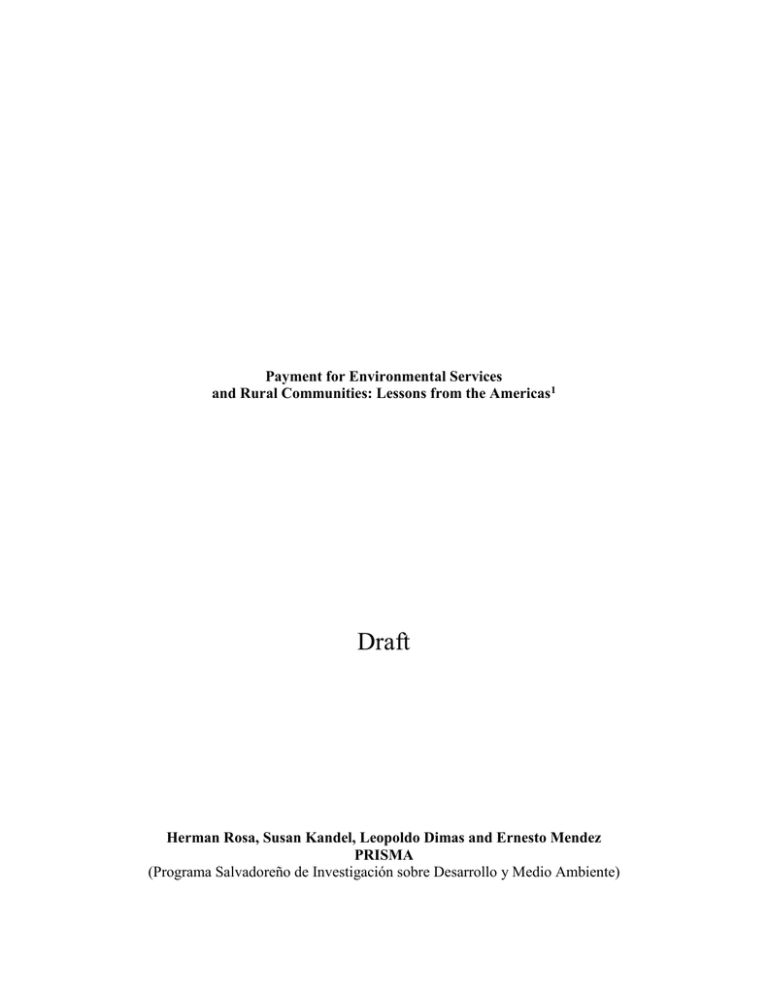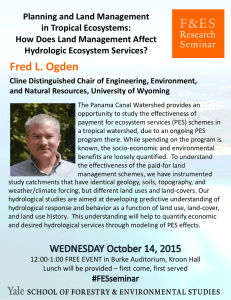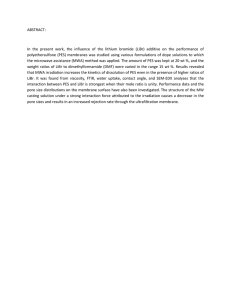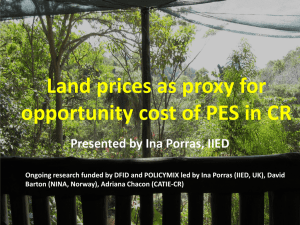Draft
advertisement

Payment for Environmental Services and Rural Communities: Lessons from the Americas1 Draft Herman Rosa, Susan Kandel, Leopoldo Dimas and Ernesto Mendez PRISMA (Programa Salvadoreño de Investigación sobre Desarrollo y Medio Ambiente) 2 1. Introduction. In many parts of Latin America and in other parts of the world, ecosystems continue to be degraded undermining their capacity to provide environmental services vital to humankind, such as hydrological services (water storage, water flow regulation and filtration), biodiversity conservation, climate change mitigation, scenic beauty, etc. At the same time, traditional natural resource-based rural livelihoods face escalating threats as a result of ecosystem degradation, reduced access to natural resources, low prices for agro- and forest-based products, as well as a generally unfavorable policy environment. In that context, over the last decade there has emerged an increasing interest in exploring Payment for Environmental Services (PES) schemes in order to increase the flow of resources for maintaining ecosystem integrity or for recovering degraded ecosystems. Water-related services are receiving increasing attention in many developing countries where one finds attempts to set up (PES) schemes for the protection of water resources. At the international level, biodiversity and carbon sequestration are perceived as vital global services and there have been attempts to introduce PES schemes. The discussion and practice so far has mainly focused on developing schemes that in a costeffective manner can achieve environmental objectives, largely ignoring the implications of the emerging schemes for poor rural communities and their livelihoods. Generally, the conventional approach to PES schemes shows certain characteristics: a) It focuses on the use of economic instruments seeking lowest cost possible for achieving environmental goals; b) it singles out environmental service (carbon sequestration, water regulation or filtration, or single species biodiversity); c) it shows a preference for simplified and large scale ecosystems preferably owned by few people to reduce transaction and monitoring costs; and d) it seeks to secure private property rights and to reward landowners. When this conventional approach provides benefits for poor rural communities, this occurs not by design, but due to particular features of the context where the scheme is applied. For instance, if the scheme is applied in a context where poor communities have secure and undisputed rights over landscapes critical for the provision of environmental services, it is likely that the communities will reap benefits from a PES scheme. More often, communities’ rights to the resource base are limited, insecure and under threat from more powerful actors. In those cases, PES schemes either sideline communities or creates a dynamic that further undermines their access rights to natural resources, in an effort to ‘protect’ them or when the most powerful actors manage to secure private property rights over resources that previously have been managed by communities. This highlights the importance of embedding PES schemes within broader natural asset building strategies that alongside PES-related internalization strategies – measures to reward low-income communities and individuals for providing ecosystem services via stewardship of natural assets – simultaneously advance the redistribution and (re)appropriation of natural resources and the direct investment to improve and restore the natural assets in the hands of the poor. Together, these asset-building strategies can help to improve rural livelihoods, while at the same time advancing environmental goals. 3 A review of contexts and PES-related experiences in the Americas sheds additional lessons that need to be taken into account when seeking to reward poor communities for their role in guaranteeing the flow of environmental services through their stewardship of the natural resource base. While not a panacea for rural poverty, PES – when it is inserted into broader strategies geared towards expanding the whole basket of assets in the hands in the poor – can help to improve rural livelihoods at the same time that it advances environmental goals. PES can also catalyze local efforts to construct shared visions that revalorize the rural landscapes managed by these communities, and can increase the awareness of other actors to the key role played by indigenous and peasant communities in managing natural resources and complex ecosystems that are critical for the provision of environmental services vital to humankind. 2. PES in the Americas: Context and Experiences The PES Project, coordinated by PRISMA and funded by the Ford Foundation, set out to identify opportunities, challenges and risks that PES poses for poor rural communities, through a review of experiences and initiatives related to payment for environmental services in the Americas (specifically Mexico, El Salvador, Costa Rica, Brazil and New York State). Table 1: Contexts and Cases for PES-related Activities in the Americas explored under the PRISMA-Ford Payment for Environmental Services Project Context Cases Costa Rica Adjusted Water Tariff (Heredia), Sarapíqui and Platanar River Microwatersheds Mexico Bioclimatic Fund (Chiapas), UZACHI (Oaxaca), Ecotourism (Oaxaca and Veracruz). Brazil Subsidy to Rubbertappers, Acre; Compensation for Environmental Services (CES) in Gurupá; Jaú National Park and Matâ Atlantica Area, Vale do Ribeira. El Salvador Shade-grown coffee small farmers in Tacuba; Biodiversity-friendly Coffee Project; Chalatenango Environmental Committee; PES in San Francisco Menéndez New York PES in the Catskills/Delaware Watersheds In Costa Rica, the country with the longest experience in formal state-driven PES schemes, new experiences are emerging that operate outside the established framework and that engage in a greater way small producers and local communities. In Oaxaca, Mexico, indigenous communities (Unión de Comunidades ZapotecoChinantecas - UZACHI) engaged in community forestry are exploring the potential for environmental services provision of the territory under their control, including bioprospecting and carbon sequestration. 4 In the state of Acre in Brazil, under the 1999 Chico Mendes Law, rubber-tappers organized in associations or cooperatives receive a subsidy in recognition of their forest stewardship function. In New York State, the city of New York fully funds infrastructure improvements and provides other incentives to dairy farmers in the Catskill and Delaware watersheds to reduce non-point source pollution of the city´s drinking water supply. In El Salvador, the interest in PES schemes is catalyzing efforts to integrate the provision of environmental services in local and territorial development proposals. Small producers engaged in shaded-coffee production are also exploring PES schemes that recognize the biodiversity and water related environmental services coming from their farms. These PES-related experiences and the national contexts in which they occur provide highlight different opportunities and pitfalls that need to be taken into account when attempting to develop PES schemes that can actually benefit the rural poor. Costa Rica Costa Rica has one of the more formalized state-driven PES schemes. This scheme has developed closely linked to forestry and conservation interests. Costa Rica used subsidies for the forestry sector since the late 70s to encourage reforestation, but had to abandon them in the nineties under structural adjustment programs. To maintain the flow of resources to the forestry sector, the forestry law was amended in 1996 to introduce the concept of payments for environmental services to the forestry sector. With funding coming mainly from the gas tax, the scheme has mobilized significant resources for the forestry sector, which strongly influenced the rules for the application of the scheme. Since 1997, US$57 millions were paid to landowners and the scheme covered around 283,000 ha. However, the requirements for land titles, the forest orientation and technical requirements favored larger private landowners. Nevertheless, as indigenous communities and small producers increased their influence, the rules of the system have evolved to become more inclusive. Indigenous reserves increased their participation and agro-forestry systems were finally made eligible through a presidential decree in June 2002. Although initially the PES scheme discriminated against small producers, their limited inclusion shows that it can have positive impacts on small producers and rural communities within their area of influence. Case study work in the Sarapiquí and Platanar watersheds shows that although incomes derived from PES payments are not considered significant by the producers involved, they derive other benefits from their engagement with the supporting organizations, such as training to develop forestry activities, strengthened organization and improved external links. There is also a positive transformation of the local landscape and this is highly valued by the local communities for what they perceive as positive impacts on the environmental services most relevant to them, chiefly better regulation and quality of water. They also appreciate the amenity value of the improved landscape, and scientific, ecological, and adventure tourism activities have developed, marketed by the supporting organizations. For instance, it is estimated that 50,000 tourists visit Sarapiquí annually, benefiting some 250 members of the local communities. 5 As the local communities increasingly appreciate the values of their natural assets, and as they strengthen their social capital, they seek to have better control over the uses of the local environment. Although this has in some cases exacerbated environmental conflicts, the process points towards a strengthening of local environmental management capacities, and an increasing appropriation of the landscape by the local actors. Mexico Mexico presents some interesting contrasts with Costa Rica. It has so far no formalized PES scheme that applies at the national level. Instead the initiatives come from below, from peasant and indigenous communities and their supporting civil society organizations, who apart from promoting local level initiatives, also seek to motivate the national government to include PES schemes in its rural programs. The promise of PES for rural communities in Mexico lies in its particular land tenure situation – unique in the Americas in the sense that peasant and indigenous communities have ample access and control to the natural resource base, to the extent that up to 80% of the forest lands is under their control. With this condition of ample access to the resource base fulfilled, the case studies from Mexico – in Chiapas, Oaxaca and Veracruz – highlight other dimensions that are key for PES initiatives that diversify and strengthen the livelihood strategies of peasant and indigenous communities. As in Costa Rica, supporting intermediary organizations to a large extent determine the general orientation of the PES-related initiatives. More specifically, they play key functions of scientific research, technical assistance, certification, fund management, marketing, and linkages with national and international actors. Strategic relationships between the intermediary organizations and the communities they support, that empower the communities and their organizations, are proving vital to the success of the initiatives. At the community level, organizational capacity seems a crucial dimension as the provision of environmental services requires in many cases landscape-level agreements on land use and practices that need to be sustained over long periods of time. This capacity for collective action becomes particularly important when dealing with heterogeneous landscapes where it is necessary to manage land use operations in an integrated fashion at different scales. The development and application rules of participatory planning and management tools for different landscape scales is particularly helpful in these cases. Organizational capacity is also proving necessary to deal with the inevitable internal conflicts that arise over the distribution of benefits and other issues, and to deal with the conflicts with the supporting organizations and other external actors. The initiatives in Mexico also point to the convenience of building up the supply of environmental services from the existing production strategies through diversification, as in the case of agricultural producers who expand their agroforestry activities for carbon sequestration or water regulation, or through bundling or marketing of environmental services in their existing 6 production as in the case of biodiversity-friendly shaded coffee. The need to build the demand for environmental services also appears as a critical aspect. This highlights the importance of the marketing function, but also the role played by the regulatory and institutional frameworks in creating demand at the local, national and international levels. Brazil In Brazil, indigenous and peasant communities have much less influence than in Mexico and their access to natural resources has for long been much less secure. For this very reason, the cases from Brazil illustrate the importance of initiatives geared towards expanding, defending and securing the rights of communities to the resource base, as a precondition for socially inclusive PES initiatives. An interesting development in that regard was the creation of extractivist reserves – a new type of conservation area enacted in 1990 in Brazil that instead of restricting access and usufruct rights of the forest communities, expands and guarantees them by law. Brazil has also shown for some time a strong interest in exploring the use of economic instruments for conservation, and this experience highlights the fact that the orientation and application of economic instruments is much more important that the specific choice of the instrument. For instance, Brazil channels a small percentage of the receipts under the sale tax (ICMS) to municipalities in proportion to the area they set up as conservation units. Since the rules establish that municipalities receive resources in proportion to the size of the areas they protect, there is an incentive to restrict community access to areas that can be set aside as reserves, unless countervailing mechanisms are in place that ensure that resource dependant communities interests are adequately represented. An exceptional example of the use of economic instruments to pursue social goals, while meeting environmental objectives is found in the State of Acre. Here, under the Chico Mendez Law, R$ 0.40 per Kg of rubber collected is paid to rubber tapper associations in extractive reserves in recognition of their role as guardians of the forests. Beyond financial flows, the Brazilian study argues for the use of a wide range of compensations for environmental services (CES), but warns at the same time that such compensations should not be used as a substitute for fulfilling the obligations to the rural and forest communities in terms of basic services. At the same time, it strongly recommends expanded and improved community participation and involvement in CES instruments and processes, both those in place and those in the awareness-building, design or negotiating phase. El Salvador Tiny El Salvador, with few remaining forests and a long history of human modified landscapes, forces us to look beyond the forest to other land uses for the provision of environmental services, such as traditional agro-ecosystems and improved agricultural practices. Small shaded coffee farms in El Salvador, for instance, show higher complexity and greater potential in terms of 7 biodiversity conservation of flora and fauna than large-scale monocultures, including single species plantation forests. Improved agricultural practices in areas predominantly managed by small farmers have also come to be seen as critical for water provision for urban areas. However, under the current macroeconomic context, heavily-biased against agriculture and small farmers, there is little likelihood the necessary improved practices will be adopted, unless farmers are also compensated for the provision of the environmental services derived from those practices. In an economy fueled by migration and remittances, where agriculture is bankrupt and no longer relevant in macroeconomic terms, the increasing recognition of the importance of environmental services offers the promise of reinserting rural areas and their communities in the national development process, by making their restoration and conservation important national priorities. El Salvador also highlights the complexities of dealing with socially and ecologically heterogeneous landscapes, with a view towards improving their capacity for providing environmental services, while at the same time strengthening the livelihoods of the rural poor. In addition, El Salvador stresses the importance of the factors already identified in the other countries, such as expanded access to the resource base, strengthened social organization, improved and increased participation in the rule-making process, significant support in terms of scientific knowledge and technical assistance, and an enabling institutional and policy environment. New York The state of New York in the United States illustrates the importance of the national regulatory frameworks in igniting PES-related initiatives, such as the New York City (NYC) funded Watershed Agricultural Program in the Catskill/Delaware watersheds. These watersheds account for 90% of NYC water supply system and a 1989 ruling by the federal Environmental Protection Agency that applied at the national level required filtering of this surface water unless a watershed plan to protect water quality was put in place. To avoid a US$6 billion plant for Catskill/Delaware, the city agreed to fund a watershed management program, whose centerpiece, the Watershed Agricultural Program (WAP), fully funds infrastructure and other assistance on a voluntary basis, with a focus on larger dairy farms as this was seen the most cost-efficient way to reduce non-point source pollution. However, the exclusion of smaller farms or those farmers who had previously adopted good environmental practices, created conflicts forcing the scheme to evolve in order to become more inclusive. This case also illustrates the importance of broadly-based negotiated rules based on shared landscape visions. Initially, for New York City the Catskills/Delaware watersheds were just a source of water, and the farmers in them, simply a threat to be managed with land use restrictions. For the farmers, in turn, the watershed defined livelihoods, identity and community. The restrictions proposed by NYC threatened the right to live according to their landscape vision. The struggle to impose the particular landscape visions was resolved through negotiations. The shared landscape vision than resulted is reflected in the Watershed Agricultural Program. NYC accepted agriculture as the preferred land use for the watershed. The farmers, in 8 turn, jointly assumed commitments to transform their practices with substantial support from NYC. 3. Key Lessons From the varied contexts and experiences outlined above, several broad lessons emerge: It is vital to pay close attention to the rule making process when using economic instruments in PES schemes to ensure that application rules are not biased against the poor. A landscape perspective to environmental services provision may be more adequate for developing socially inclusive and environmental sound PES schemes; Supporting social capital accumulation may be critical to ensure landscape management schemes that both guarantee the continued provision of environmental services and benefit sharing schemes that actually benefit the poor; Expanding, defending and innovating communities’ rights of access, usufruct and control of natural resources, seems to be a prerequisite and necessary condition for PES schemes that favor the rural poor. The importance of application rules of economic instruments to ensure equity The concept of payment for environmental services emerged from an economic discussion on how to internalize externalities in the production process. Mirroring the discussion on the use of economic instruments to reduce negative externalities such as contamination through the internalization of the costs, in the nineties there began an exploration on the use of economic instruments to maintain and expand the flow of positive externalities, such as environmental services, by internalizing the benefits, either through direct payments to those responsible for maintaining certain land uses, or through market development and creation of environmental services. Economic instruments have certain advantages. Taxes and charges on consumers of environmental services are extremely useful for mobilizing financial resources. Subsidies can be targeted to specific actors in exchange for specific activities that ensure the provision of environmental services. Markets for environmental services, once the rules are established, can function automatically through the interaction between environmental services providers, intermediaries, and consumers. As long as they exist, markets can also provide powerful incentives to land managers and producers to enhance and maintain ecosystem functions that provide environmental services. Powerful as they can be for achieving environmental objectives in a cost-efficient manner, economic instruments need also to be harnessed through rules that ensure that the benefits also flow to poor rural communities. Otherwise, they will most likely be excluded and greater inequity will be the end result. In general, the rules are related with the requirements established to participate in the schemes based on economic instruments (land titles, technical requirements, eligible activities, monitoring, and certification criteria, etc.) and with the objectives and general approach that orient the use of the instruments. 9 Here the international agreements, the national, state, and local governance structures play a critical role, since they carry the main responsibility in terms of defining the framework and the rules for the application of economic instruments, which to a large extent determines the potential for inclusion or for exclusion for the instrument. Indeed, when economic instruments turn out to be effective tools for strengthening the livelihoods of poor rural communities, this is usually because the state or the local government ensures that this is so (IIED, 2001). Since in most cases, the rules tend to be established by the more powerful and wealthy actors, an explicit and deliberate effort is required: to ensure the participation of rural communities and the inclusion of their interests in the rule-making process; to expand, defend and secure their access, usufruct and control rights over the resource base; to enhance their technical capacities and increase their market power; and to strengthen their organization. The equity or inequity of the rules applies not only to those who receive the payments or compensations for the provision of the environmental services, but also to those who consume such services and that are required to ‘pay’ for them. PES schemes can result in greater inequity if they create additional costs to consumers already in a highly disadvantageous position, or they can result in perverse arrangements where low-income communities end up paying large high-income landowners for the environmental services flowing from their lands. In general, adequate rules require the setting up of negotiation processes. This often includes the determination of payment or compensation levels in PES schemes. Traditional economic valuation – although often proposed – does not seem particularly useful in most cases. Other techniques, based on consultation and deliberation, seem to be more appropriate for arriving at adequate compensation schemes. For instance, in Australia the combination of Multiple-Criteria Analysis and a Citizen’s Jury informed by expert opinion is used to define values and priorities for environmental services through a structured deliberative process (Land and Water Australia, 2002). Science also has a role to play in these processes. Although in practice, most PES-related schemes have emerged as part of a negotiating process with little support of scientific evidence concerning the actual provision of environmental services, science can play an important role. However, it is important to clarify the purpose of the scientific inquiry. In the negotiation phase, scientific references can help clarify the issues and define overall priorities. In the operational phase, more concrete scientific evidence may be necessary to optimize the schemes in terms of defining the most appropriate practices and the most appropriate sites for interventions. In any case, given the complexity of heterogeneous landscapes, the scientific enquiry is necessarily an iterative process of successive approximations that starts with informed guesses. The relevance of a landscape perspective A landscape can be understood as ‘a geographical mosaic composed of interacting ecosystems resulting in the influence of geological, topographical, soil, climatic, biotic and human interactions in a given area’(Martin et al. 2000). The application of this concept to environmental services is particularly useful, because it highlights the fact that such services are generated and 10 distributed through a great variety of land uses. It is also congruent with the fact that currently rural areas are increasingly mosaics with different land uses, such as forests, diverse forms of agriculture, and disturbed areas with trees or human settlements (Gliessman, 2002). A landscape perspective moves away from idyllic concepts of nature undisturbed to the heterogeneous complexity of land uses at they exist in reality. If forces us to look at all the components of the landscape and their particular features that impact positively or negatively on the capacity for generating environmental services. It also forces us to look at the interactions amongst the components, which in some case may be critical for generating those services. For instance, the conservation of vegetation species in a tropical forest can be enhanced with the genetic material of individuals in neighboring agroforestry systems or agroecosystems. Similarly, within a geographic mosaic, some components act as critical linkages to allow the flow of environmental services. Thus, even altered and degraded patches can play an important role in maintaining the flow of environmental services. Landscape mosaics are also by definition multifunctional, providing at the same time several environmental services. A landscape perspective, by highlighting and valuing and this complexity can avoid the danger of focusing on single environmental services and promoting landscape transformations that impoverish rather than enhance the landscape, as in the case of monocultures. In the long term, the generation and conservation of environmental services demand integrated landscape management schemes that include, harmonize, and value all the components present in the landscape. This often involves negotiation and conflict resolution mechanisms, given the different and often conflicting demands, interests, and visions of the actors present in a landscape mosaic. Social capital accumulation as a critical variable Social capital can be understood as the organizational capacities in a locality and the ability to secure resources (knowledge, collective action, access to markets, etc.) as a result of membership in social networks or other social structures. This concept includes two key dimensions of social capital: the capacity of a community to use its organizational structure to discuss, agree, implement and monitor actions and activities among its members; and the quality and density of external social networks employed for receiving support and resources that advance community goals. The key elements that constitute the source of social capital are: relations of confidence; reciprocity and exchanges; common rules, norms and sanctions; and connections, networks and groups. (Petty y Ward, 2001) Thus understood, social capital becomes crucial for the continuity in the provision of environmental services since producers and land managers within a landscape need to act in a concerted fashion in order to ensure that provision. Relations of confidence facilitate cooperation, and a history of reciprocity and exchanges contribute to long-term obligations among persons, thus favoring effective organization. The existence of common rules, norms and sanctions forms the basis for constructing new management institutions (conflict resolution, graduated sanctions, etc.). Social capital also serves as a bridge for constructing the larger 11 management units that may be necessary for the provision of environmental services and for the reduction of monitoring and transaction costs. Social capital accumulation is also essential to ensure that PES schemes effectively benefit poor rural communities. Without strong social organization and external linkages, poor communities cannot influence the rules of PES or other compensation schemes, nor can they effectively conduct a struggle to expand, defend, and secure their access, usufruct, and control rights to the resource base. Social organization is also required to negotiate successfully the proposals of intermediaries and external agents, so that they effectively contribute to reducing existing vulnerabilities through the diversification and strengthening of livelihoods strategies. Social organization is also needed to deal with the internal distribution issues and other conflicts that arise when new benefits to flow to the communities. The quality and density of existing networks facilitate PES mechanisms, as support organizations play essential roles in these processes. Institutions or NGOs that provide technical assistance, operational support, or links and mediation with other institutions or markets are critical in helping bring about both successful and unsuccessful PES schemes. Those who are endogenous to the community or outside organizations that are sensitive to local processes of appropriation, and that respect and defer decision-making to local actors and/or producers, appear to favor the development of PES schemes that benefit poor rural communities. We also need to be aware that supporting institutions can, at times, be detrimental to PES processes and communities. A large number of intermediary/supporting institutions can seriously reduce the benefits that the producers and communities receive. Supporting organizations can also hinder the processes of appropriation by the communities. Problems can arise when there are differing or conflicting concepts of PES and/or its focus, between intermediary organizations and the communities. Since outside organizations usually hold the key that opens the door to funds or other benefits, there is always a danger that they will try to impose their own agenda on the community, not respecting internal processes of appropriation, local knowledge and final say on whether to enter into particular PES mechanisms. It is particularly important to avoid in this regard establishing as an preconceived end goal the setting up of a PES scheme, as it may turn out that PES is not a viable, desirable or beneficial option for certain communities. The precondition: Expansion, defense and innovation of communities’ rights of access, usufruct and control of natural resources The common property regime theory provides a useful framework for exploring the relationship between property rights, environmental services and livelihoods. Under that framework, following Schlager and Ostrom property rights include: the right to enter and enjoy nonextractive benefits (access rights); the right to extract products (extraction rights); the right to regulate internal use patterns and transform the resource (management rights); the right to determine who has the rights to access and extraction and how these rights are transferred (exclusion rights); and the right to transfer the rights of management and exclusion (alienation rights). 12 Poor rural communities do not need full alienation rights, as in private or state property schemes, to be able to benefit from schemes that seek to internalize the flow of environmental services coming from the natural and disturbed ecosystems. But they need to have at least secure usufruct rights to be able to benefit, as in the extractive reserves in Brazil. This allowed rubber tappers to move a step further to recognize and compensate the role of extractive communities in maintaining the ecosystem integrity and hence the flow of environmental services. Management rights as in the case of ejidos or social property scheme in Mexico goes a step further, as it gives the communities a large say in determining land uses and production options. Thus, it is possible to explore how to integrate the conservation and production of environmental services into these options. Land redistribution programs, as those carried out in El Salvador in the eighties and nineties, that give full title to the land, have also expanded the options for these integrating these options in the livelihoods strategies of many peasant communities. Thus, besides determining to a large extent the livelihood possibilities of rural communities, property rights are also a determining factor in how natural resources are managed. In this respect, their expansion, defense and innovation, by creating a long-term interest in maintaining the flow of goods and services of the natural resource, can also improve the supply of environmental services. In turn, recognition of the role of rural communities in providing those services can result in a stream of benefits for the communities. 4. Conclusions PES is not a panacea for poverty alleviation and rural development. PES schemes can only provide limited additional income and other benefits for indigenous and peasant communities. Nevertheless, they can be useful mechanisms for diversifying existing livelihood strategies, improving the management of natural resources, and catalyzing local efforts to construct shared visions that revalorize the rural landscapes managed by these communities, and drawing awareness by the external actors to the key role played by indigenous and peasant communities in managing natural resources and complex ecosystems that are critical for the provision of environmental services vital to humankind. In general, to ensure that PES-related processes really benefit rural communities, they should not be pursued in an isolated fashion or as ends in themselves. Instead, they should be inserted into broader strategies geared towards expanding the whole basket of assets in the hands in the poor. Within the natural assets framework, the implication is that PES-related internalization strategies need to be embedded within broader natural asset-building strategies that simultaneously expand the control of the communities over the resource base through redistribution and (re)appropriation, while mobilizing resources for direct investments geared towards improving and restoring natural assets to the hands of the poor. PES-related processes can better meet the needs of rural communities, when they adopt a landscape perspective that takes into account all the components of the landscape and their interactions. Supporting social capital accumulation is also crucial for furthering agreements for landscape management schemes that can guarantee the conservation, expansion and continuity in 13 the provision of environmental services, and for ensuring that the rules of PES or other compensation schemes are biased in favor of the communities, and also to ensure an adequate distribution of the benefits within the communities themselves. Given the crucial role of social capital, the costs of strengthening organizational capacities demanded by PES schemes and natural asset building strategies in general, must be taken into account. While these costs are substantial in the beginning, they will drop considerable when the organizational capacity is developed. In this sense it is useful to consider an investment in social organization as similar to start up capital. Philanthropic organizations can play a key role in leveling the playing field for entrance into PES schemes to small producers, by financing social capital formation through the support and strengthening of local processes. This investment will have benefits for the target community, as well as the management of their natural resources, regardless of whether or not a PES scheme is achieved. 5. Postscript on the Lessons Learned2 The Importance of application of rules of economic instruments to ensure equity. It has been demonstrated that markets for environmental services, once the rules have been established, can function automatically through the interaction between environmental service providers, intermediaries, and consumers. Yet, most programs intending to promote PES schemes place special emphasis on the importance of markets or prototype programs to design the incentives to land managers and producers to enhance and maintain ecosystem services functions and provide environmental services. The PES schemes studied here involve government, donor or other institutional interventions to help create or establish trial mechanisms capable of providing the incentive, which will hopefully set the standard for the market to recognize later. The design of the incentive or bundle of incentives is often the most challenging part of the effort to promote PES, as it becomes one of the principle links between the producer or land manager and the larger PES mechanism. Here, it is important to draw from relevant experience in promoting changes in cultural practices for the dual purpose of maintaining or increasing production, while improving environmental conditions. Two sources of experience in the use of these incentives provide illustrative insights: the promotion of agro-forestry and soil conservation practices, both with small and poor producers. The results are mixed and need to be reviewed, as the track record has shown limited success over a long-term horizon. However, the lessons learned point to the possibility of greater success when the ‘incentive’ scheme is applied to the larger social structure (groups of families or communities as opposed to individual farmers) and when more flexible in its application (move from compensation ‘tied’ closely to the specific technical activity – for example, planting of live barriers – being implemented, to allow for a broader set options for the use of the incentive, such as support to local health or educational needs or infrastructure.) A third insight gained from experience in these two fields is that continuity in changed management practices is usually more predominant when the individual family members – especially women – reap other benefits from the impact of the applied management change, such as the reduction in their time searching for fuel and water. 14 The insights provided from these two fields of practice and reflection tend to confirm the importance of designing the incentive scheme and its related payment or compensation arrangement in such a way that it is linked to the larger social context and its organizational structures, and include the direct participation of these organizations. They also point to the importance of interlinking the activities proposed for PES schemes to guarantee multiple environmental benefits for the local population. It will be important to promote learning from this past experience to help shape these crucial details of international PES agreements, national programs and local projects. The Relevance of the Landscape Perspective A crucial issue to consider, when embarking upon the task of actually promoting PES in the countryside, is how to ‘construct’ the landscape-level effort. A closer look at the dynamics of social decision-making and the landscape mosaic reveals their intimate relationship, thus the need to contemplate both from the beginning. Here, there are greater insights and lessons to be learned from the experiences within the cases studied, particularly on the collective and relatively large land-holdings in Mexico (ejidos) and Brazil (extractive reserves). Within the confines of each type of landholding, decisions are made between the members on how to manage the delicate balance of different land-uses for different needs: self-consumption, collective production or harvesting for the market, raising animals, maintenance of water and fuel sources, and the location of human settlements. Similar questions arise at the landscape level, when promoting PES between different producers or managers and their families with distinct landholdings. Shared concerns quickly focus on how to optimize the production or harvest of crops or products for self-consumption and/or marketable products that guarantee a constant and sufficient stream of income, while introducing the management changes necessary for the PES mechanism to work. Questions asked become, what are the changes needed during the transition period, in order to turn the land-use degradation process around, while generating sufficient income, before the actual payment or compensation ‘kicks in?’ Are there any gains to be made by introducing changes or alternatives at a larger scale that goes beyond the individual farm or ejido level, such as relocating or ‘swapping’ a forested area for one under agriculture production, in order to improve the larger landscape? Could expanding the scale of production (including many plots, farms or ejidos) allow for a change in crops that could contribute to the provision of environmental services, or increase income flows? Would a larger scale, collaborative effort at land restoration or conservation allow for the introduction of new alternatives such as eco-tourism, otherwise impossible? The most successful efforts have been processes where a larger common goal and gain can be found among those actors within the landscape. Presenting the challenges and questions that arise from the actors themselves reveals the intimate relationship between the potential for ‘building’ the landscape level effort and the degree of social cohesion and organization necessary within each one. Social capital accumulation as a critical variable 15 An important set of prescriptions for building social capital has emerged from the lessons learned in this study. Here we focus on the following: To ensure the participation of rural communities and the inclusion of their interests in the design of the PES schemes and mechanisms and the rule-making process; to expand and secure their access, usufruct and control rights over the resource base; to enhance their technical capacities and increase their market power all require not only strengthening their organizations, but in many cases helping them to create new ones, and to influence the nature of existing institutional arrangements around them. Many of the communities and their organizations that will become involved in PES schemes aimed at benefiting the rural poor are incipient grassroots-level associations, or groupings of communities or producers, often physically distant from the major cities, lacking communications and transportation infrastructure and suffer from the characteristic woes of poor rural communities, such as low levels of educational and poor heath facilities. How to ensure that they are capable and have the chance to reach the goals mentioned above is a tall task. Most of these organizations will not be able to reach the levels of professionalism required within the ranks of their membership, nor with the limited financial resources available. Yet, the demands placed upon them require the mobilization of high levels of technical expertise and training, applied scientific knowledge and increased political legitimacy and visibility. For example, forest communities or rubber tapper organizations may not be able to maintain qualified staff on board for each of these areas and be financially viable. Thus, they will be constantly involved in negotiations processes for hiring outside technical expertise, for contracting the sale of their wood or other forest products, for representing and defending their legal interests over resource access, and fighting to keep others (often mining, petroleum, conservation or large-scale tourism). They will inevitably need to gain some expertise in each of these areas, in order to be able to increase their negotiation ability, based on a sound understanding of their interests and the threats. This type of training becomes an important area for contribution to social capital building. We also need to allow for creativity and flexibility in the emergence of new management institutions. Previous models for development work have begun to show some ‘fraying at the edges’, where often grassroots or base organizations openly criticize the intermediary organizations providing them with technical expertise and training, advocacy skills and contacts, or represent them before local to international authorities. Government programs have been belied with unsuccessful attempts to provide technical services, mostly determined at the central level and ‘delivered’ to the rural organizations. As PES schemes gain experience and legitimacy officially, the emergence of new institutional arrangements could be legitimized, and may become an inspiring source of influence for determining new roles for government institutions, agencies and programs. It will be important to help these emerging efforts gain visibility and legitimacy for such purposes. 16 Endnotes This draft is based on the forthcoming publication ‘Payment for Environmental Services and Rural Communities: Contexts, Experiences and Lessons from the Americas’, to be available on PRISMA´s website www.prisma.org.sv . This paper summarizes the results of the Payment for Environmental Services (PES) research project, coordinated by PRISMA and funded by the Ford Foundation, that sought to identify opportunities, challenges and risks that PES poses for poor rural communities, through a review of initiatives related to payment for environmental services in the Americas (specifically Mexico, El Salvador, Costa Rica, Brazil and New York State). 1 2 The postscript was written by Deborah Barry.






